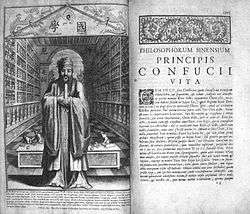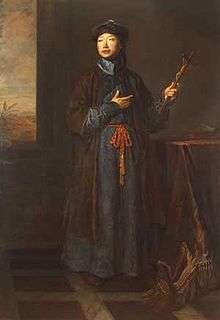Philippe Couplet

Philippe Couplet, also Philip Couplet or Philippus Couplet (1623 – 1693) (Chinese name:柏應理), was a Belgian Jesuit Father who was active in China in the 17th century. He was born in Mechelen, Spanish Netherlands (now Belgium).[1]
Career
Chinese career (1656–1681)
Philippe Couplet entered the Jesuit Order in 1640. His interest in China was aroused by a lecture by Martino Martini, a former Jesuit missionary to China.[1] Couplet initially left for China in 1656, in a group of new Jesuit recruits led by Michał Boym, who was returning to China with the Pope's response to the Southern Ming's Yongli Emperor plea for help.[2] Couplet took various responsibilities throughout China, but had to take refuge in Canton during the 1665-1670 persecutions.[1]
Couplet worked closely with Candida Xu (Chinese: 徐甘第大, Xu Gandida) (1607–1680), a granddaughter of Xu Guangqi and a devout Christian herself. Under her patronage, he was able to set a number of new churches throughout Jiangnan.[2]
Mission to Europe (1681–1693)
Couplet was sent back to Europe in 1681 as Procurator of the China Jesuits in Rome. His mission was to obtain papal agreement for the liturgy to be sung in Chinese.[1] On his visit to Rome he gave the Pope a library of Chinese translations of Christian books.[1] While in Europe, his visit to king Louis XIV triggered plans for the dispatch of five Jesuit "mathematicians" to the Chinese Court.[1]

Upon his return to Europe in 1685 Couplet brought with him two Chinese converts, including Michael Shen Fu-Tsung (Miguel Shen Fuzong), one of the first Chinese men known to visit Europe, who visited Italy, France and England.[3][4] Soon after, Couplet and Shen answered questions about the nature of the Chinese language posed by linguists in Oxford,[5] Berlin and Vienna.[3]
Publications
In 1686 Couplet published in Paris Tabula chronologica monarchiae sinicae, a "chronological table of the Chinese monarchy", in an attempt to show that there was agreement between the Septuagint and the Chinese chronological records.[3] To prove his point he had to add 1400 years to the time period that existed between Creation and the birth of Abraham.[3] This however did not satisfy the European intelligentsia or the missionaries in China.[3] His work nevertheless had a major impact in other areas of European science.[6] Leibniz, for example, was able to establish, after communicating with the Jesuits, that the binary system he had invented also existed in the Yijing.[6]
In 1687, leading a group of Jesuits (Prospero Intorcetta, Christian Wolfgang Herdtrich, and François de Rougemont), Couplet published Confucius Sinarum Philosophus ("Confucius, Philosopher of the Chinese"), an annotated translation of three out of the Four Books from which the study of the Confucian canon traditionally started.[7] The work (parts of which had appeared earlier in separate, little known, editions) was a culmination of the efforts of several generations of Jesuit missionaries,[8] and was dedicated to King Louis XIV.[3][9] The preface to the translation[10] highly praised the works of Confucius:
"One might say that the moral system of this philosopher is infinitely sublime, but that it is at the same time simple, sensible and drawn from the purest sources of natural reason... Never has Reason, deprived of Divine Revelation, appeared so well developed nor with so much power."— Preface to Confucius Sinarum Philosophus.[11]
Prior to returning to China he stayed in Europe until a dispute between the vicars apostolic of the Asian missions, to which he had taken an oath of obedience, and the Portuguese padroado system, his initial tutelary organization, was resolved.[1] After negotiations that lasted for eight years, the two sides were able to reach an agreement and Couplet finally departed for China.[1]
As Couplet was travelling back to China, a heavy chest fell on his head during a storm in the Arabian Sea, severely injuring the septuagenarian Jesuit. He died the next day, 16 May 1693, as his ship was about to reach Goa.[12]
Works
- Philippe Couplet and Prospero Intorcetta, Confucius Sinarum philosophus, sive Scientia sinensis latine exposita (Parisiis: Apud Danielem Horthemels ... 1687). Getty Internet Archive Free Online Digital Version.
- Tabula Chronologica Monarchiae Sinicae (1686)
- Breve raguaglio delle cose piu notabili spettanti al grand'imperio della Cina (1687)
- Histoire d'une dame chrétienne de la Chine où par occasion les usages de ces peuples, l'établissement de la religion, les manieres des missionaires, & les exercices de pieté des nouveaux chrétiens sont expliquez (Paris, 1688). Biography of Candida Xu.Free Online Digital Version Staatsbibliotek zu Berlin
See also
Notes
- 1 2 3 4 5 6 7 8 Gerald H. Anderson, Biographical Dictionary of Christian Missions, p. 155
- 1 2 Mungello, David E. (1989). Curious Land: Jesuit Accommodation and the Origins of Sinology. University of Hawaii Press. pp. 253–254. ISBN 0-8248-1219-0.
- 1 2 3 4 5 6 Lach, Donald F (1973). "China In Western Thought And Culture". In Wiener, Philip P. Dictionary of the History of Ideas. ISBN 0-684-13293-1. Retrieved 2009-12-02.
- ↑ Ballaster, p.262
- ↑ See Nicholas Dew. Orientalism in Louis XIV's France. Oxford: Oxford University Press, 2009 (ISBN 978-0199234844), pp. 205-208.
- 1 2 University of Barcelona website
- ↑ Nicholas Dew. Orientalism in Louis XIV's France. Oxford: Oxford University Press, 2009 (ISBN 978-0199234844) has an entire chapter on the publication process of this work in Paris and the role of the royal librarian Thévenot in this enterprise.
- ↑ Mungello 1989, pp. 17, 253–258
- ↑ The Dragon and the Eagle: The Presence of China in the American Enlightenment - Page 17 by Alfred Owen Aldridge (1993)
- ↑ See Urs App, The Birth of Orientalism, Philadelphia: University of Pennsylvania Press, 2010 (ISBN 978-0-8122-4261-4), pp. 146-159, for a discussion of the important role of this preface in the Western discovery of Buddhism.
- ↑ Quoted in Hobson, p.194
- ↑ Mungello, p. 257
References
- Anderson, Gerald H. (1999) Biographical Dictionary of Christian Missions, Wm. B. Eerdmans Publishing, ISBN 0-8028-4680-7
- Ballaster, Rosalind (2005) Fables of the East: Selected Tales 1662-1785, Oxford University Press, ISBN 0-19-926734-0
- Hobson, John M. (2004) The Eastern Origins of Western Civilization, Cambridge University Press, ISBN 0-521-54724-5